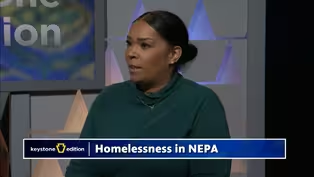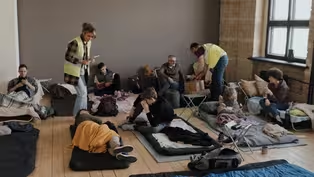Keystone Edition
Understanding Homelessness: A Systemic Challenge
Clip: 2/3/2025 | 9m 23sVideo has Closed Captions
Homelessness is systemic, underreported, and affects all.
The discussion highlights the pervasive and systemic nature of homelessness, emphasizing that it affects people from all walks of life. Organizations are shifting to a dignity-forward approach, offering permanent shelters and vital resources like IDs. Youth aging out of state aid face severe challenges. The federal definition of homelessness is debated, with underreporting due to stigma and fear.
Problems playing video? | Closed Captioning Feedback
Problems playing video? | Closed Captioning Feedback
Keystone Edition is a local public television program presented by WVIA
Keystone Edition
Understanding Homelessness: A Systemic Challenge
Clip: 2/3/2025 | 9m 23sVideo has Closed Captions
The discussion highlights the pervasive and systemic nature of homelessness, emphasizing that it affects people from all walks of life. Organizations are shifting to a dignity-forward approach, offering permanent shelters and vital resources like IDs. Youth aging out of state aid face severe challenges. The federal definition of homelessness is debated, with underreporting due to stigma and fear.
Problems playing video? | Closed Captioning Feedback
How to Watch Keystone Edition
Keystone Edition is available to stream on pbs.org and the free PBS App, available on iPhone, Apple TV, Android TV, Android smartphones, Amazon Fire TV, Amazon Fire Tablet, Roku, Samsung Smart TV, and Vizio.
Providing Support for PBS.org
Learn Moreabout PBS online sponsorship- I really love that first soundbite.
Diana Delgado says she knows 60 of the 70 names.
That was almost a little emotional for the two of you watching that story, can you speak to why?
- I think that we have this narrative that homeless individuals or unhoused individuals are different than us, but if you look on your payrolls, you look in your classrooms, you look the person sitting next to you, the face of homelessness is every single person you've ever met.
It reaches out and touches everyone.
And I think making that connection, making people feel like they are not defined by their housing status, using their first name, calling them a guest, that makes a big difference because we have to be dignity-forward when we address homelessness, because no longer is homelessness a person's deficit, they've done something to get themselves into this, this is a societal, structural, systemic issue, and it's important.
- I would like to go to Sarah first.
You came to us and said, "You know what, this is a topic we really want to dive into."
I know you've been doing a lot of reporting in this area.
What have you found?
- So, one of the things that I've found is that as this need has been rising, one of the good things that's been happening in the area is places like Keystone Mission have been able to open permanent programs.
When I first started reporting on this issue and I spoke with Keystone Mission, this was a temporary space that would only open on code blue nights when it was- - Very cold.
- Yes, when it was dangerously cold and we wanted to bring people inside from the cold.
Now there is this permanent space.
People who are experiencing homelessness can use Keystone Mission as an address.
- Yep.
- And those little things that I see these organizations doing are adding that dignity that you spoke about and making these people feel less invisible and less out of society.
- Mm-hmm, yeah.
- Absolutely.
And I think that, like you mentioned, it used to be just a place where you can come and have this reprieve from the cold weather, but what we recognize is there's such a higher need of services, especially with vital records and getting IDs and things like that for individuals, that we had to expand, and we're thankful that we were able to.
- Maureen, I know that you handle teens at your center.
Can you talk about some of the challenges there?
- Well, it's been a very interesting education for me over the last few years about homeless teens.
You think that they're out there, but you aren't really sure.
And then when somebody comes to you and says, like in Luis' case particularly, he turned 18, and the check that his aunt was receiving for supporting him stopped, and no money, no housing.
And that's been the case for many of our teens, is they age out of state benefits, WIC, EBT, but that mouth still needs to be fed.
- That's a very vulnerable time too, 18.
I can imagine that that's a vulnerable time.
- Because they're not mature yet, they don't have life experiences, they don't have very good decision-making abilities.
And what I have found is that when they're kicked out, they're so ashamed.
And they also feel very incompetent because they don't know how to take care of themselves.
They don't know how to find an apartment.
They don't know that you need 2 to $3,000 to get an apartment right now, cash, right?
Because you have to have first and last month's rent, damage deposit.
- Security.
- Yeah, and also the utility companies require deposits when you're a first-time customer ever.
They don't have credit scores, they don't have credit cards.
They don't have their, very often, their personal documents, their social security card or their birth certificate.
And so we try to help them find those things and then show them the order that they can obtain those documents, get services, and teach them how to budget.
And if they're working, if they're still in high school, we request that they work part-time.
But part-time work is not gonna pay the rent in the open market, forget it.
But if they are done with school and they work full-time, we work with them to learn how to budget to save for their own apartment when they're finished with our program.
- You were talking about the pit count, and I think that's a lot of where Sarah's statistics came from.
Could you explain what that is and why you would go through that?
- Yeah, so, the point-in-time count is the federal survey that is used nationally, it is one time a year, it's one night in January.
The Department of Human Services and HUD administers the test.
They create it, or excuse me, they create the survey, and they give it to shelters.
I believe shelters, schools sometimes.
And it just asks the individuals who are participating where they slept the night before.
So, on January 30th, it'll ask, where did you sleep on January 29th?
It'll give a list of options.
And they use that to kind of get an idea of how many homeless individuals are within the area.
Homeless individuals or unhoused individuals are hesitant to participate in any kind of survey or information-gathering devices because of fear of the system, a lack of trust in the system, a lack of trust in individuals.
So that's very hard.
It's a great thing because at least we have some numbers, but homeless tracking, tracking unhoused individuals, it's very under-reported due to the lack of trust in the system.
- So there's one reason why we think it's very under-reported.
What are some other reasons, Maureen, that someone might not know?
- Well, I think the definition of homelessness is different for the federal government than what we consider homeless.
The federal government says that homelessness is someone staying overnight in a situation that is not fit for human needs.
So, maybe there's no restroom or there's no furniture, there's no heat or air conditioning, versus we would say homelessness is couch surfing, sleeping in a vehicle, bouncing from relative to relative, if you've got them, sleeping in dumpsters, (chuckles) anywhere, that's warm.
A few years ago, kids told me that they were sleeping in the garage at Steamtown Mall.
- They find the nooks and crannies, and they set up a little sleeping place, and they hope they aren't found.
But that's not fit for human existence, so.
- There also is, I think too, and I know Maureen can attest, like, the lack of wanting to disclose.
So especially for families that are doubled up or living in their cars, are more reluctant to disclose their housing status for fear of losing their children, fear of losing their benefits if they're receiving benefits.
- Section 8.
- So, yeah, we have to do better as a society to decriminalize these things and not have this fear to report so that we can provide the services that are needed.
- It's interesting that you bring up families, because the point-in-time count did find that across the nation, people and families with children had the largest reported increase.
So that could be changing a little bit, but, as we say, that is under-reporting still.
- Yeah, so what we have seen, what I have seen is that we're seeing an increase in the individuals we see, not just as adults, but dual-income households, families.
Typically, we would see an increase in adults that are experiencing homelessness.
But as of the point-in-time from last year, we have seen an increase, not just on the paper, but also calls, individuals coming in needing food assistance for their families.
And they're living doubled up, they're living in their cars, and they're not reporting that because they're afraid that they're gonna lose their children.
- And the school district reports over 350 families, again, self-reported, are homeless, so, using the HUD definition.
- Using that.
Well, I guess, I wonder why, you know, the definitions vary very widely.
Are they different even in the state or among different districts?
Would that help be helpful for you to have?
- Well, the public school system has to use the federal definition.
- Sure, right.
- But nonprofits have more latitude (chuckles) to accept what a homeless person is living with.
- Yeah, displacement, transitional.
We kinda have the leeway to kind of come as you are.
We'll help you in every way that we can.
- We are gonna continue this discussion on homelessness right after this short break.
Stay with us.
Breaking the Barriers: Addressing Homelessness Through Housing and Social Change
Video has Closed Captions
Clip: 2/3/2025 | 10m 23s | Breaking the Barriers: Addressing Homelessness Through Housing and Social Change (10m 23s)
Homelessness in NEPA - Preview
Preview: 2/3/2025 | 30s | Watch Monday, February 3rd at 7pm on WVIA TV (30s)
Rising Homelessness and the Struggle for Affordable Housing
Clip: 2/3/2025 | 3m 46s | Homelessness is rising due to high living costs, as shelters struggle to provide support and housing (3m 46s)
Providing Support for PBS.org
Learn Moreabout PBS online sponsorship
- News and Public Affairs

Top journalists deliver compelling original analysis of the hour's headlines.

- News and Public Affairs

FRONTLINE is investigative journalism that questions, explains and changes our world.












Support for PBS provided by:
Keystone Edition is a local public television program presented by WVIA


